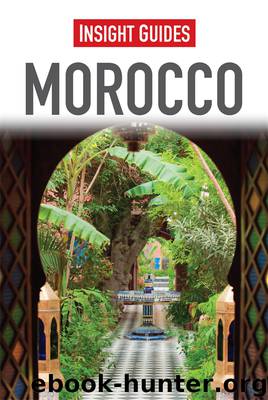Insight Guides: Morocco by Insight Guides

Author:Insight Guides
Language: eng
Format: epub, azw3, mobi, pdf
Tags: Travel, Morocco
Publisher: APA
Published: 2014-06-30T04:00:00+00:00
Jewish Fez
The mellah – the first Jewish quarter in Morocco – was originally sited by the Bab Guissa gate. When Fez el Jdid was built, the Jews were ordered to move to their new quarter near the Sultan’s palace. Many Jews with interests in the medina preferred to become Muslims and thus stay in Fez el Bali. Those who did move were promised protection in consideration of supplementary taxes.
The name mellah, which means ‘salt’ in Arabic, alludes to the job of draining and salting the heads of decapitated rebels before they were impaled on the gates of the town, a task traditionally done by Jews. Morocco’s Jews held an ambiguous position prior to the protectorates; although they were ostensibly under the Sultan’s protection, their freedom was limited. No Jew was allowed to wear shoes or ride outside the mellah, for instance, and further restrictions were placed on their travel elsewhere.
Very few Jewish families are left. What remains are their tall, very un-Arabian buildings with distinctive wooden balconies which line the lively Rue des Merinides, the heart of the district. Just off this road lies the Ibn Danan Synagogue ^ [map] (Sat–Thu, no set hours, a guardian will let you in; donations), which dates from the 17th century and is a reminder of the mixed cultural heritage of Morocco. After falling into disrepair, the synagogue was restored in collaboration with the World Monuments Funds and Morocco’s Ministry of Culture and reopened in 1999.
The nearby Jewish Cemetery (Cimetière Israelite de Fes) is one of the oldest in Morocco, with rows of tightly packed, pristine white gravestones laid out on the slope of the hill stretching down towards the river. The adjacent Habarim Synagogue (daily 7am–7pm; donations) contains the remains of several eminent rabbis, as well as a woman who allegedly refused to convert to Islam and marry the Sultan and was killed as a result.
The west end of Rue des Merinides emerges into the spacious Place des Alaouites. Dominating the square is the flamboyant Royal Palace & [map] (Dar el Makhzen; closed to the public) &, originally built by the Merenids but constantly reworked ever since, and most of what you can see today is largely modern. The entrance to the palace bounding Place is undoubtedly impressive, in a slightly Hollywood sort of way, with huge brass doors surrounded by multi-coloured bands of plasterwork, zellige and calligraphy. The grounds, said to cover 40 hectares (100 acres), are enclosed by high walls.
Ville Nouvelle
West of Fez el Jdid stretches the Ville Nouvelle, built by the French after World War I on a grid system that is simplicity itself to navigate after the medina. Fez’s Ville Nouvelle is less interesting than others in the country, lacking the Maurequse touches of Casablanca and Rabat, or the sheer glamour of Marrakech, although there’s a decent if uninspiring selection of hotels and restaurants here if you prefer not to stay in Fez el Bali. The Ville Nouvelle is also usually livelier than the medina in the evenings,
Download
Insight Guides: Morocco by Insight Guides.azw3
Insight Guides: Morocco by Insight Guides.mobi
Insight Guides: Morocco by Insight Guides.pdf
This site does not store any files on its server. We only index and link to content provided by other sites. Please contact the content providers to delete copyright contents if any and email us, we'll remove relevant links or contents immediately.
The Old Farmer's Almanac 2020 by Old Farmer’s Almanac(1700)
1610396766 (N) by Jo Ann Jenkins(1639)
Botswana--Culture Smart! by Michael Main(1572)
Whatever You Do, Don't Run by Peter Allison(1533)
In Arabian Nights by Tahir Shah(1531)
Dead Eye by Mark Greaney(1485)
Livingstone by Tim Jeal(1460)
The Templars by Michael Haag(1396)
Ubuntu by Ellis Heather;(1384)
Top 10 Israel and Petra by DK Travel(1370)
Africa: Altered States, Ordinary Miracles by Richard Dowden(1367)
First Comes Love, then Comes Malaria by Eve Brown-Waite(1364)
Morocco Travel Guide by Lonely Planet(1354)
Egypt Travel Guide by Lonely Planet(1350)
False Papers by André Aciman(1326)
The Promise of a Pencil: How an Ordinary Person Can Create Extraordinary Change by Braun Adam(1323)
Jeff Corwin by Jeff Corwin(1295)
The Masked Rider by Neil Peart(1262)
African Nights by Kuki Gallmann(1235)
